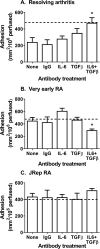Identification of a transitional fibroblast function in very early rheumatoid arthritis
- PMID: 28847766
- PMCID: PMC5705853
- DOI: 10.1136/annrheumdis-2017-211286
Identification of a transitional fibroblast function in very early rheumatoid arthritis
Abstract
Objectives: Synovial fibroblasts actively regulate the inflammatory infiltrate by communicating with neighbouring endothelial cells (EC). Surprisingly, little is known about how the development of rheumatoid arthritis (RA) alters these immunomodulatory properties. We examined the effects of phase of RA and disease outcome (resolving vs persistence) on fibroblast crosstalk with EC and regulation of lymphocyte recruitment.
Methods: Fibroblasts were isolated from patients without synovitis, with resolving arthritis, very early RA (VeRA; symptom ≤12 weeks) and established RA undergoing joint replacement (JRep) surgery. Endothelial-fibroblast cocultures were formed on opposite sides of porous filters. Lymphocyte adhesion from flow, secretion of soluble mediators and interleukin 6 (IL-6) signalling were assessed.
Results: Fibroblasts from non-inflamed and resolving arthritis were immunosuppressive, inhibiting lymphocyte recruitment to cytokine-treated endothelium. This effect was lost very early in the development of RA, such that fibroblasts no longer suppressed recruitment. Changes in IL-6 and transforming growth factor beta 1 (TGF-β1) signalling appeared critical for the loss of the immunosuppressive phenotype. In the absence of exogenous cytokines, JRep, but not VeRA, fibroblasts activated endothelium to support lymphocyte.
Conclusions: In RA, fibroblasts undergo two distinct changes in function: first a loss of immunosuppressive responses early in disease development, followed by the later acquisition of a stimulatory phenotype. Fibroblasts exhibit a transitional functional phenotype during the first 3 months of symptoms that contributes to the accumulation of persistent infiltrates. Finally, the role of IL-6 and TGF-β1 changes from immunosuppressive in resolving arthritis to stimulatory very early in the development of RA. Early interventions targeting 'pathogenic' fibroblasts may be required in order to restore protective regulatory processes.
Keywords: Fibroblasts; adhesion; endothelial cells; lymphocytes; rheumatoid arthritis.
© Article author(s) (or their employer(s) unless otherwise stated in the text of the article) 2017. All rights reserved. No commercial use is permitted unless otherwise expressly granted.
Conflict of interest statement
Competing interests: HMM has received research funding from Pfizer. All other authors declare that they have no conflicts of interest.
Figures




References
MeSH terms
Substances
Grants and funding
LinkOut - more resources
Full Text Sources
Other Literature Sources
Medical

